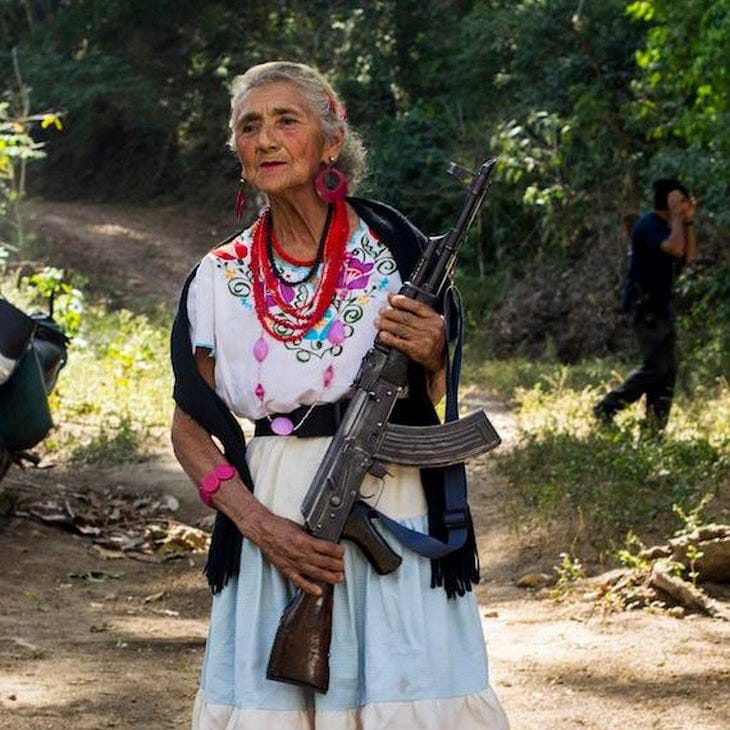She's Not Fake. She's Real. Coming Soon: The Other Side of Immigration
If you think it's bad at the border, look further south.

Soon we will discuss a particular situation in Mexico, epitomized by the image of the woman above. She is one of the defenders of a village in Mexico in which the only men still there are boys under 12 and men over 60. She is defending her village against the rape, pillaging, and murder carried out by gangs who find such villages easy prey because there are no able-bodied male defenders to protect them. Sometimes even children are armed to try to maintain freedom and retain the village’s food supplies.
So where are the men? They’re in America where they often work for next to nothing but still manage to send money home to the villages—and even if it’s a pittance, it’s more than they’ve have made in Mexico, if, indeed, they’d been able to find jobs at all.
In 2020, at the height of the pandemic, the Center for American Progress (CAP) released a report detailing the workforce engagement of the 10.4 million undocumented immigrants in the United States. At that time, more than 5 million of them were essential workers in pandemic times. Key findings from CAP’s report include:
Undocumented immigrants make up approximately 3.2 percent of the U.S. population, but 4.4 percent of the country’s workforce.
There are more than 7 million undocumented immigrants working in the United States.
In 41 states and Washington, D.C., there are more than 10,000 undocumented workers, and in 16 states that total is greater than 100,000.
In every state, undocumented immigrants make up a larger share of the workforce than they do the total population.
California and Texas are home to the largest undocumented workforce, with 1.4 million and 1.2 million undocumented workers, respectively.
More than 1.4 million undocumented immigrants work in construction, accounting for 13 percent of all construction workers.
Nearly 1 million undocumented immigrants work in accommodation and food services, approximately 8.4 percent of all workers in the industry.
710,000 undocumented workers make up 10 percent of the administrative and support and waste management industries, and another 489,000 undocumented workers in nonpublic administration services are also overrepresented in the field.
Approximately 25 percent of workers in farming, fishing, and forestry occupations are undocumented—although this is likely an undercount—as are 16 percent of workers in construction and extraction occupations.
15 percent of workers in building and grounds cleaning and maintenance occupations are undocumented.
7 percent of workers in food preparation and serving-related occupations are undocumented.
7 percent of workers in production occupations are undocumented.
6 percent of workers in transportation and material moving occupations are undocumented.
Nearly 1 in 5 landscaping workers, maids or housekeepers, and construction laborers are undocumented immigrants.
Nearly 30 percent of agricultural workers or painters are undocumented.
More below …
Undocumented immigrants on the front lines of the response to the pandemic included:
5 million—nearly 3 in 4 undocumented immigrants in the workforce—are considered essential workers according to the U.S. Department of Homeland Security’s latest guidance.
An estimated 1.7 million work in the nation’s food supply chain—from 358,000 farmworkers and food processors to 154,000 working in supermarkets, grocery stores, and convenience stores.
Nearly one-quarter of a million—236,000—undocumented immigrants are working as health care providers, including:
15,000 registered nurses and licensed practical nurses
19,000 lab and diagnostic technicians
139,000 home health aides, nursing assistants, and personal care aides
Another 188,000 undocumented immigrants are working in health care settings as custodians, food servers, and administrative workers to keep hospitals, nursing homes, and labs functioning.
Beyond their presence in the workforce, undocumented workers make major contributions to the U.S. economy through taxes they pay annually. Key findings include:
Undocumented workers and their households pay $79.7 billion in federal tax contributions and $41 billion in state and local tax contributions.
These households hold $314.9 billion in spending power.
Undocumented immigrants own 1.6 million homes, paying $20.6 billion in mortgage payments each year, while other undocumented workers pay $49.1 billion in rental payments annually.
On top of their federal tax contributions, undocumented workers also buoy the social safety net; their employers annually contribute payroll taxes totaling $17 billion for Social Security and $4 billion for Medicare, for which undocumented immigrants are ineligible.
So, employers pay undocumented workers pay annually at least $17 into Social Security — and $4 billion into Medicare — when those migrants will never see a penny of those benefits as they will go into the system illegally under the names of Americans who will reap those benefits when they retire.
And back home, women and children try to hold on in families that poverty, cartel abuse, and corrupt governments separated — and that corrupt American corporations, hiring undocumented workers that enrich both their coffers and American social funds brought here with a lure of jobs that is quite real. Why else would people risk the Darien Gap or the razor wire in the Rio Grande?
A special treat for yearly subscribers.
Our Mug (for Yearly Subscribers) Has Your Name Written All Over It
This is the mug we did for Robert J. Rei, who’s got a Substack newsletter we REALLY like, and he is letting us use her to model for us. Our mugs are personalized for our yearly subscribers. Please support our efforts if you can. PolitiSage is written by …



Thank you for the illuminating post.
Mexico started around the same time as America.
A huge country full of natural resources, wealth and huge populations.
They opened their country to immigrants. People came from all around the world.
For the most part, they're all assimilated into mainstream Mexican culture now.
Just like the immigrants to America did.
But the country failed to develop.
Corruption at the highest level.
That's the reason why all the village escape to America to work.
They don't want to. But they have no choice.
The rich Chilangos in Mexico City don't give a shit about them.
Mexico created it's only damn decaying society.